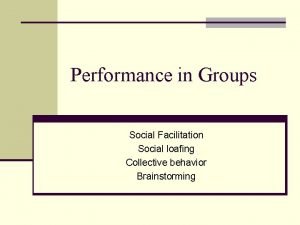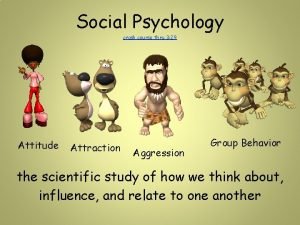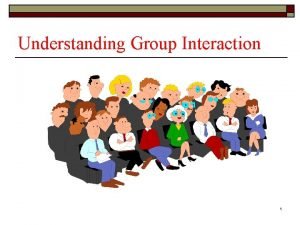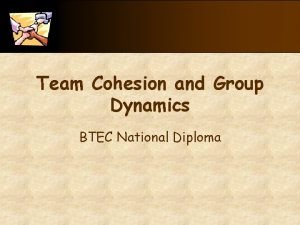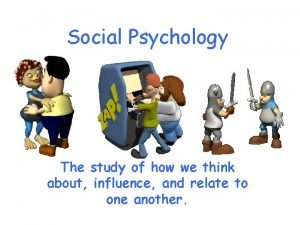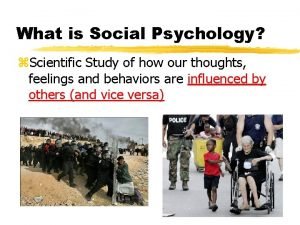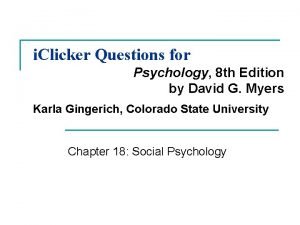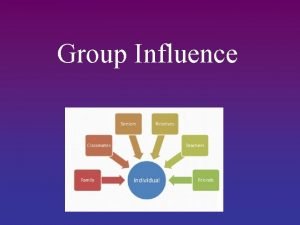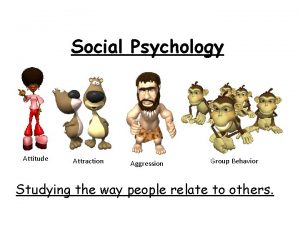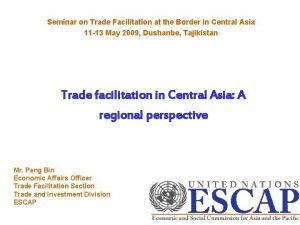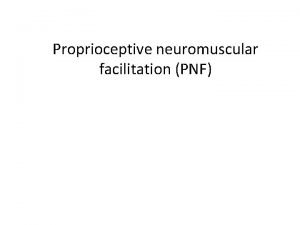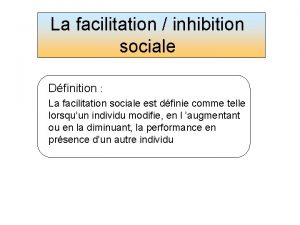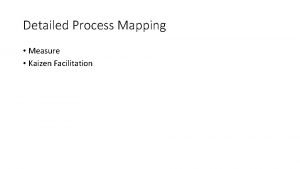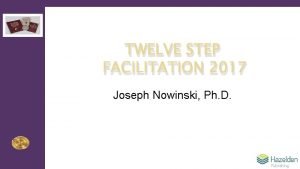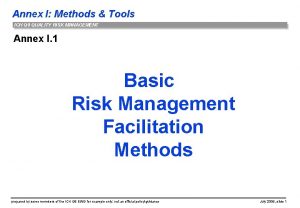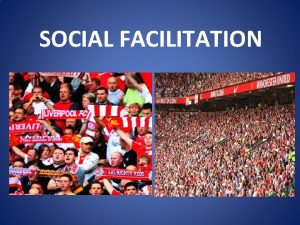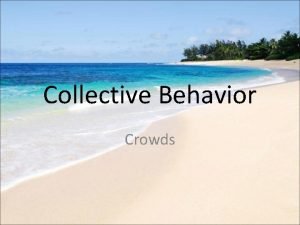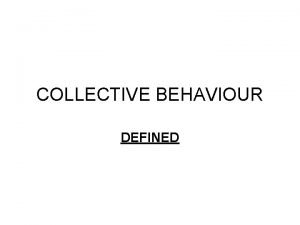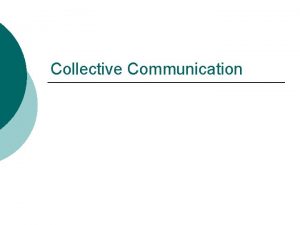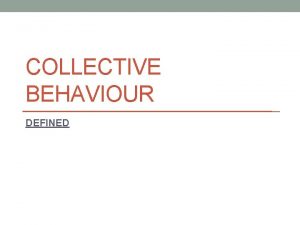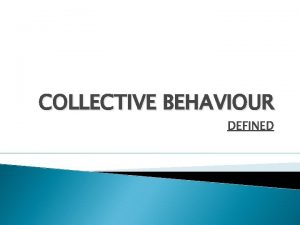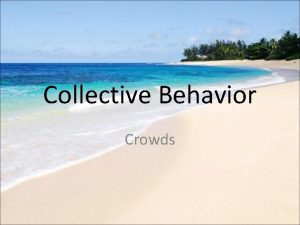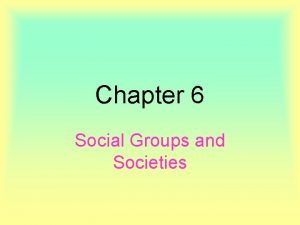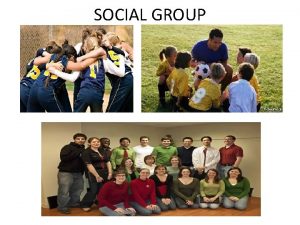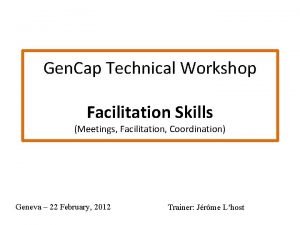Performance in Groups Social Facilitation Social loafing Collective
































- Slides: 32

Performance in Groups Social Facilitation Social loafing Collective behavior Brainstorming

Activity n Task: n Using two pencils in one hand (like chopsticks) individually pick up jellybeans from one cup and place them in the other cup.

Triplett’s (1898) study n Triplett n Noticed bicyclists performed better when riding with others n n Study with children performing simple task either alone or with others. Results: n Children performed better when in the presence of others compared to when alone

I. Social Facilitation n Enhancement and impairment performance effects resulting from the presence of one or more persons n Social facilitation: n Performance enhancement n Social inhibition: n Performance impairment

The Scope of Social Facilitation n Many contradictory findings: n Sometimes people performed better in the presence of others and sometimes people performed worse n Interest in social facilitation dwindled (40’s & 50’s) n Zajonc integrated the divergent results n Distinction between dominant and nondominant responses

Social Facilitation a la Zajonc n Dominant response: n Well-learned or instinctive behaviors that the organism has practiced and is primed to perform n Nondominant response: n Novel, complicated, or untried behaviors that the organism has never performed (or performed infrequently) n Presence of others increases our tendency to perform dominant responses

Research Examples n Cockroach study (Zajonc et al. 1969) : n n Not limited to humans! Cockroaches performed simple or difficult task n Runway or maze Measured speed when alone or with fellow roaches present Presence of other roaches facilitated performance on easy task and hampered it on difficult task

Cockroach study Seconds

Research Examples n Pool room study n n n (Michaels et al. , 1982) Players identified as above or below average Research team of 4 approached the table and observed playing Found classic facilitation/inhibition effects

Pool room study % shots made

The Social Facilitation Effect Performance Improves Know the task well Perform task in presence of audience Do not know the task well Performance Declines

Why Does Social Facilitation Occur? n Three basic processes highlighted: n Arousal n Evaluation apprehension n Distraction-conflict theory

Increased arousal Presence of Other People Evaluation Apprehension Cognitive conflict Distraction Social Facilitation of Dominant Responses

II. Social Loafing n Ringlemann effect n Social loafing n Members work below their potential when in a group n i. e. , people getting lazy in groups

Amount of Individual Effort Exerted The Social Loafing Effect High The greater the number of people who work on a group task, the smaller the contribution any one member of the group will make Low One person Small working alone groups Number of People Working Large groups

Research Example n Shouting experiment n n n (Latane, Williams, Harkins) SS separated into rooms with headphones Led to believe they were shouting alone or with others Results: n Groups of 2 shouted at 66% capacity n Groups of 6 at 36% capacity n People exhibit a sizable decrease in individual effort when performing in groups compared to alone

Ways to Reduce Social Loafing ü Identify individual ü ü ü performance. Form smaller work groups. More task structure and specialized roles Direct and immediate feedback Increased personal involvement Group cohesion

III. Collective Behavior

Collective Behavior n Deindividuation: n Loss of sense of individuality. This loss reduces constraints against "deviant" behavior. n Conditions promoting deindividuation n When you feel anonymous; unlikely to be caught n When environment focuses your attention away from the self

Zimbardo’s (1969) Model of Deindividuation Crowd Reduced self-awareness Reduced accountability Input Variables Anonymity Shared/diffused responsibility Group size Arousal Sensory input overload Physical involvement in the act Novel and unstructured situations Altered consciousness through drugs, alcohol Disinhibition Output behaviour Subjective changes Decreased self-observation and -evaluation Decreased Concern for social evaluation Emotional, impulsive, irrational, regressive and extreme behaviour Uncontrolled behaviour Distorted memory/ perception Hyper-responsiveness to immediate surroundings Liking for group Destruction of traditional forms and structures

Classic Studies n Focused on anonymity and its effects

Research Examples

Research Examples n Trick or treat study (Diener et al. 1976) n n n Children trick or treated alone or in group 1/2 Trick or treating children asked name; other 1/2 not All children given the opportunity to steal extra candy

Trick or Treat Study % transgressing

Another Account of Collective Behavior n Social Identity explanation: n In the crowd the person doesn’t lose a sense of individuality rather the person transitions from a personal identity to a social identity n Social identity n When social identity is made salient, people internalize group norms as their own. If group members behave normatively, collective behavior results.

Research Examples n KKK vs. nurses study (Johnson & Downing 1979) Participants identified by name or anonymous n Participants wore KKK or nurses costumes n Then given opportunity to shock n

“Deindividuation Effects” Depend on Normative Cues

Collective Behavior Explanations Compared DEINDIVIDUATION n Cause: Anonymity, arousal, noise, other external factors demanding attention n Process: Loss of identity, decreased (self) awareness n Outcome: Disinhibition, anti- normative behavior, suggestibility SOCIAL IDENTITY n Cause: Factors inducing identity salience n Process: Transition from individual to social identity n Outcome: Normative behavior, responsiveness to group norms


Brainstorming n Brainstorming groups often create fewer ideas than individuals because: n n social loafing blocking (because of waiting turns, ppl forget ideas or decide not to share) evaluation apprehension n social matching (lower standards of performance are n matched) n What can be more effective?

Brainstorming Exercise Page 302 n "Each year a great many Americans go to Europe to visit. Now suppose that Americans want to entice Europeans to come to America. What steps would you suggest to get more Europeans to visit America? "

Post Performance Review 1. How many ideas do you think you, as an individual, generated while brainstorming? 2. In general, do you believe you would produce more ideas alone or by brainstorming in a group? 3. In general, do you believe you would produce more creative ideas by alone or by brainstorming in a group? 4. Evaluate the process your group used to generate its ideas. a. Did the production of ideas change over time? b. Did some individuals in the group produce more than others? c. Did your group follow the rules of brainstorming? 5. Did any of the following coordination and motivational factors influence your group's performance? a. Social loafing b. Evaluation apprehension c. Blocking d. Social matching
 Social facilitation vs social loafing
Social facilitation vs social loafing False consensus effect
False consensus effect Social psychology definition
Social psychology definition Attribution theory ap psych
Attribution theory ap psych The understanding group
The understanding group Steiner's model of group effectiveness
Steiner's model of group effectiveness Social loafing
Social loafing Self fulfilling prophecy
Self fulfilling prophecy Define social facilitation
Define social facilitation Social facilitation example psychology
Social facilitation example psychology What could be the most likely response
What could be the most likely response False consensus effect
False consensus effect How are ethnic groups and religious groups related
How are ethnic groups and religious groups related Business facilitation program visa
Business facilitation program visa Trade facilitation meaning
Trade facilitation meaning Indication of pnf
Indication of pnf Facilitation among species
Facilitation among species Inhibition sociale
Inhibition sociale Project management facilitation techniques
Project management facilitation techniques Process mapping workshop facilitation
Process mapping workshop facilitation Trade facilitation meaning
Trade facilitation meaning Facilitation techniques ppt
Facilitation techniques ppt The twelve step facilitation handbook
The twelve step facilitation handbook Workshop checklist template
Workshop checklist template Demonstrator teacher
Demonstrator teacher Language
Language Thank you for your facilitation
Thank you for your facilitation How to thank a facilitator
How to thank a facilitator Thank you message for the facilitator
Thank you message for the facilitator Trade facilitation support program
Trade facilitation support program Facilitation model
Facilitation model Basic risk management facilitation methods
Basic risk management facilitation methods Trade facilitation indicators
Trade facilitation indicators
